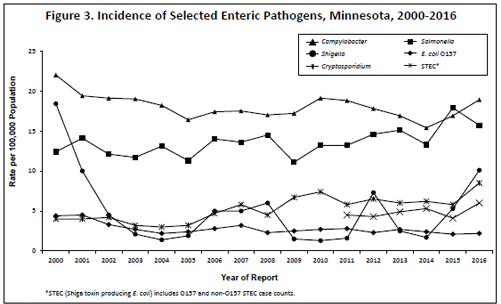Annual Summary of Disease Activity:
Disease Control Newsletter (DCN)
Related Topics
Contact Info
Salmonellosis, 2016
In 2016, 861 Salmonella cases (15.7 per 100,000 population) were reported. This is a 19% increase from the median annual number of cases reported from 2006 to 2015 (median, 724 cases; range, 578 to 975), but a 12% decrease from the 975 cases reported in 2015.
Of the 98 serotypes identified in 2016, 5 serotypes, S. Enteritidis (206), S. I 4,[5],12:i:- (100), S. Typhimurium (84), S. Newport (64), and S. Infantis (50) accounted for 59% of cases. Salmonella was isolated from stool in 743 (86%), urine in 60 (7%), and blood in 51 (6%) cases. Other specimen sources included wound (3), bone, sputum, nasal swab, and sinus.
Two hundred eleven (25%) cases were hospitalized; the median length of hospital stay was 4 days (range, 1 to 36 days). Two culture-confirmed Salmonella cases died; a 52 year-old who died of complications from cardiopulmonary arrest with cardiomegaly (Salmonella sp. was isolated from a sputum specimen); and a 65 year-old who died of respiratory failure, urosepsis, and metastatic prostate cancer (S. Mbandaka was isolated from a urine specimen).
Of the 769 cases with known travel history, 155 (18%) had travelled internationally during the week prior to their illness onset. There were 11 S. Typhi cases; 3 had traveled to or emigrated from India, 1 to India and several European countries, 1 to Kenya, 1 to Bangladesh, 1 to the United Kingdom, 1 to multiple countries in Asia, and 3 did not report any travel. There was 1 S. Paratyphi B case who traveled to Ecuador.
In 2015, culture-independent tests (CIDTs) became commercially available for the detection of Salmonella nucleic acid in stool. In 2016, 34 patient specimens that were positive by a culture-independent test conducted at a clinical laboratory were not subsequently culture-confirmed, and therefore did not meet the surveillance case definition for inclusion in MDH case count totals.
Seventy-five cases were part of 14 Salmonella outbreaks in 2016, including 3 cases that were part of two national outbreaks with no exposures in Minnesota. During January through September, 1 culture-confirmed S. Newport case, 1 culture-confirmed S. Enteritidis case, and 12 probable cases were part of an outbreak of Campylobacter and Salmonella infections among contractors working in a chicken processing plant. Multiple high-risk environmental exposures were identified among cases. One S. Montevideo case was part of a multistate outbreak of S. Montevideo and S. Senftenberg infections in nine states that was associated with pistachios. The outbreak strain of both serotypes was found in samples of raw pistachios at the farm. In March, 2 S. Oslo cases were part of a multi-state outbreak of 14 cases in eight states that was associated with Persian cucumbers. Six culture-confirmed cases and 1 probable case of S. Enteritidis infection were part of a multi-state outbreak that included 1 additional case in Virginia. The outbreak was associated with a pre-packaged leafy greens mixture of kale, spinach, chard, and carrots. Two culture-confirmed and 2 probable cases of S. Typhimurium infection were associated with exposure to Salmonella in a commercial microbiology laboratory. One culture-confirmed and 1 probable case were secondary household contacts of the 2 primary cases. During April through July, 32 salmonellosis cases were part of multi-state outbreaks of 895 cases in 48 states associated with live poultry. The Minnesota cases had serotypes S. Infantis (17), S. Enteritidis (8), S. Hadar (3), S. Indiana (3), and S. Ohio (1). This was the largest number of illnesses linked to contact with backyard poultry ever recorded nationally. Ten S. Anatum cases were part of an outbreak of 32 cases in nine states associated with consumption of jalapeno peppers from a common consolidator/grower. During May through July, 7 culture-confirmed and 2 probable cases of S. I 4,[5],12:i:- infection were associated with sushi restaurants. Traceback of suspected ingredients did not identify a common source. In June, 1 S. Reading case was associated with a multi-state outbreak of 36 cases of S. Reading and S. Abony infection in nine states. Alfalfa sprouts from a Colorado sprouter was the implicated vehicle; the Minnesota case was exposed in Colorado. Two S. Heidelberg cases from different households were associated with direct or indirect contact with one black roughneck monitor lizard, which was fed frozen chicks. During August through December, 2 culture-confirmed and 4 probable cases of S. Uganda infection were identified among workers at a turkey hatchery. Four culture-confirmed cases and 1 probable case of S. Infantis infection were linked to a Mexican-style restaurant. The vehicle was not identified. In August, 2 S. Enteritidis cases in Minnesota residents were part of a restaurant outbreak in Missouri. The vehicle was eggs from a local farmer. In November and December, 2 S. Typhimurium cases were associated with contact with hedgehogs purchased from an online private seller.

- For up to date information see>> Salmonellosis (Salmonella)
- Full issue>> Annual Summary of Communicable Diseases Reported to the Minnesota Department of Health, 2016